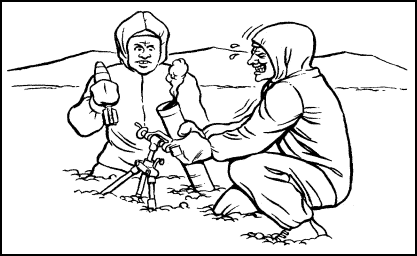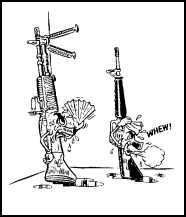Cold weather will greatly affect the operation of your weapon. You must be
aware of these effects to ensure employment of your weapon under poor weather
conditions.
Your weapon will work properly under extreme cold conditions if you take care
of it. Normal temperate zone lubricants thicken in cold weather, and stoppages
or sluggish actions of your weapon will result. During the winter, disassemble
your weapon completely, clean it thoroughly, and remove all lubricants. Oil the
entire weapon with a light coating of cleaner lubricant preservative (CLP).
A main problem is to keep snow and ice, which may disable your weapon, out of
the working parts, sights, and barrel. When the weapon is not in use, keep it
out of the snow either in an improvised weapon stand or in a tripod arrangement.
If this is not possible, stand it up with the butt end in the snow.
Condensation ("sweating") will form on the weapon when you take it from the
cold into a heated shelter. The condensation will continue for about 1 hour,
after which you should clean the weapon. If you don't, the condensation will
freeze when you take the weapon outside, and it may not fire. The weapon must be
kept as near the floor as possible to lessen condensation. If parts of the
weapon do become frozen, warm them and move the working parts slowly until they
are unfrozen. If you can't warm your weapon, remove all ice and snow and move
the parts gently until action is restored. The use of CLP will prevent
malfunctions by eliminating condensation.
When firing, do not let the hot parts of your weapon come in contact with the
snow. The snow will melt and, as the weapon cools, will form ice. When changing
barrels, don't lay them on the snow.
To prevent bipods and tripods from sinking into the snow, improvise for added
flotation. This is done by placing them on snowshoes, ski poles, branches,
ahkios, etc. Baseplates should be on solid ground or sandbags to prevent sinking
into the snow and damage to the weapon.

Figure 4-2. Bipods and tripods will sink in the snow.
AMMUNITION
Small arms ammunition should be kept at the same temperature as your weapon.
Ammunition clips and magazines must be cleaned of all oil and preservative and
checked often. All ice, snow, and condensation must be removed. Ammunition boxes
must be kept closed in order to keep out snow and ice.
Stored ammunition should be kept in packed boxes, raised off the surface by
placing them on boughs, cardboard, or other similar material, and covered to
protect them from the snow. Ammunition should be well marked for easy location
and identification in case it becomes covered with snow.
Ammunition resupply may become restricted. Everyone must be aware of the
necessity for ammunition economy and fire discipline. Loaded clips, magazines,
or single rounds dropped in the snow become quickly lost; therefore, careful
handling of ammunition is essential. Never waste your ammunition. Make every
round count.
When contact with the enemy is imminent, troop compartments and aircraft
should be kept as close to freezing as possible to avoid condensation. However,
many munitions have limitations at lower temperatures, which must be recognized
in training.



